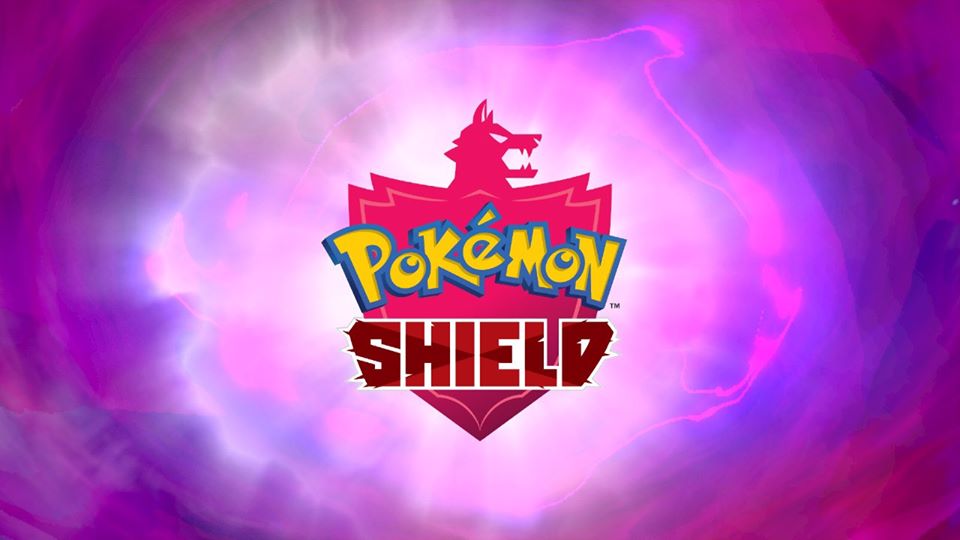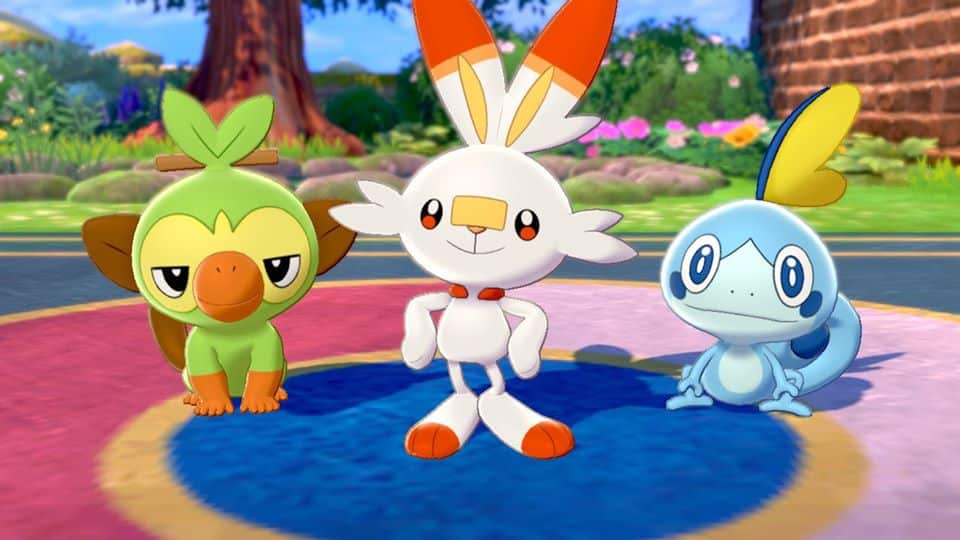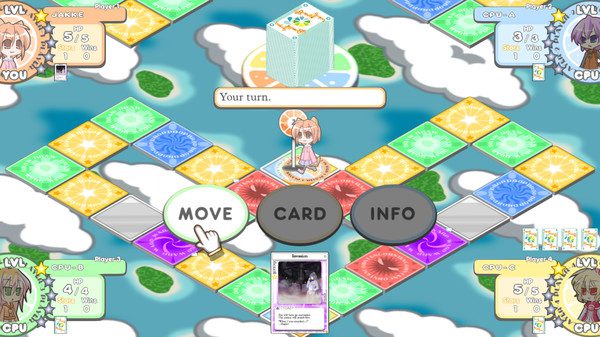I’ve been playing 100% Orange Juice, a cute little anime-style board game, with my friends, as well as playing it solo in campaign mode, quite a bit the last few days. And we’ll probably play it again tonight too. What I love about this game is that as you play you earn stars (the in game currency) and the characters can level up, which lets you unlock new costumes and new characters.
The characters all have their own stats, such as HP, ATK, and DEF, and there are cards which you can unlock to add to your deck which can further enhance these stats or help you take advantage in battle. This makes replay much higher than a regular board game. Of course, the cute anime graphics, bright colors, and bright royalty free music really add to the overall appeal of this game for any anime or retro videogame fan.
100% Orange Juice can be played by up to 4 players together online. If you don’t have 3 other friends to join you, each empty seat will be filled in by an NPC (computerized opponent) or you can search for and join other players waiting in the lobby.
PS: If you already play and love 100% Orange Juice, check out “A Game of Dice”. You can read my review for A Game of Dice right here. It’s very similar to 100% Orange Juice.
Title: 100% Orange Juice
Genre: Board Game, Card Game, Deck Building Game
Developer: OrangeJuice
Publisher: Fruitbat Factory
Platform: PC
Where to Buy: $6.99 On Steam
Geeky: 3/5
Sweetie: 5/5
Overall: 76/90 84% B “Very Good Game For Girls”
Concept: 10/10 100% Orange Juice is a crazy, zany, quirky, charming, and addictive little board/card game. It has many different modes to play in. For example, you can invite up to 3 friends to join you in a multiplayer game in the lobby, or you can play the campaign mode to see each character’s story, or you can play the game by yourself against the computer in free play mode where you won’t be interrupted by the story segments. Each mode rewards you with stars (the in-game currency) which allow you to add new cards to your deck, purchase characters, or other exciting enhancements to add into your game. Some of the rewards are locked at different levels, which makes you want to play more to level up to get the best rewards. There’s also limited edition rewards that come into the shop and sell out which makes you want to keep playing so you don’t miss any goodies.
Gameplay: 9/10 The matches feel just a touch long to me (Each match takes about 35-45 minutes) – I’d like the ability to be able to “fast-forward” some of the animation and the NPC turns, especially in the single player modes. Overall though, the gameplay is really fun. You roll a single dice to dictate how many squares you’ll move. You can also play cards before you begin each turn. There are different types of cards including: Trap Cards, these cards are ones that you place on the board for other players to land on usually with negative effects, though I have seen “trap” cards (cards you place on the board) that allow you to collect stars or warp or other things as well. There’s also Battle Cards, these cards can only be used in battle, and typically they increase or decrease the stats (ATK, DEF, EVASION, etc). Lastly, there’s (what I would call) Personal Cards, these cards are used by you to heal your character, roll two dice, get stars, or deal damage directly to another player.
As you move around the game board, there’s different types of squares that you can land on. For example, a blue square (or “drop” square) will make you roll a dice and you lose that number of stars. The green squares let you draw an extra card. The red squares generate an NPC for you to battle, and sometimes turn into “boss squares” where if you deal the final blow to the boss, you’ll get a huge amount of stars. The purple squares teleport you to another area on the map. The grey “metal looking” squares are basically “safe spots” where nothing will happen to you. The yellow square allows you to roll a dice and collect stars equal to that number.
Lastly, if you land on a square with another player or NPC, you can enter into a battle with that player. Battles consist of rolling a single dice (or sometimes playing a battle card if you have one). You roll for both attack and defense. Your character’s base stats and any card effects are then added into your dice rolls. Your scores are then subtracted from your opponent’s scores. For example, if your opponent rolls a 4 attack roll, and has a character with +2 base attack, and plays a card granting him +1 attack, his total attack score will be 7. If you roll a 4, and have a character with +1 defense base stat, and no defense granting cards played this round, your total defense is 5. So you would take 2 damage subtracted from your total HP. It would then be your turn to attack, and your opponent’s turn to defend, and the same principles would apply again. You can choose to roll Evasion instead of defense, but you must score HIGHER than (not equal to) your opponent’s attack roll – otherwise you take full damage (0 defense). However, even if you defense is higher than your opponent’s attack score, you will always take at least 1 damage when you defend, and a successful evasion will allow you to not take any damage at all. If you lose all of your HP you will be knocked out and your opponent will steal your stars. After being knocked out, you will have to roll a specified number or higher to revive and rejoin the game which sets you back quite a bit from the competition.
The objective of the game is to pass by your home point after fulfilling different objectives. After you complete the first objective, which is to collect 10 stars, you may then choose your next objective each time you go home. This can be winning a certain number of battles, or having a certain number of stars. The first player to clear 6 objectives will win the game, while 2nd-4th place will be determined by how many objectives the others have completed, as well as stars, and battle wins in case of a tie. When going home, your hit points are also fully restored, which makes finding your home base a key part of your gameplay strategy. Sometimes, depending on the game board, your home point may be inaccessible except by trying to land on the purple warp squares and praying that it puts you on the other side of the game board. To make it even more challenging, home points can change “owner” (reflected by the color) at any time. You can only use your own home point, so you have to keep track of where your home point (which matches your character’s color) is located at throughout the game.
Story: 7/10 If you like humor, you’d probably rank this score higher. Don’t get me wrong, I like to laugh too. But I much prefer more “serious” or “dramatic” types of stories. This is a bit like “low-brow” “slapstick” humor, but it is cute and “Otaku-pandering” and it gets the job done. I think it’s pretty cool that every character has their own stories. Once again, increasing that sweet replay value. Especially when you get into the unlockable characters and DLC – there’s probably over 30 different characters and each have their own campaign (story) modes.
Characters: 9/10 The characters are also very cute and each one has it’s own unique personality (and story). If you’re a fan of other games by OrangeJuice (which are mostly “bullet hell” games) then you will recognize many of the characters from their other games. For me, not having played those games, the characters are new, but still very loveable. The animation and expressions and enthusiasm each character shows throughout the game is really endearing, even if the story and character development is a bit weak.
Graphics: 8/10 As mentioned, 100% Orange Juice features adorable anime graphics, which yes, maybe aren’t the highest quality, but they add to the overall cute-ness of the game. They are a little bit pixelated, and the characters are very simplistic in design – however, the ability to customize your characters with different outfits, or unlock a multitude of dozens of new characters, as well as the expressions, animations, and personality of each character make it a very “kawaii” game.
Music: 8/10 It has a good soundtrack – although not enough different songs, which can lead to it becoming repetitive if you play many games of 100% Orange Juice in a row consecutively. The tracks that are there though are really cute and catchy. I just wish there was more of them – if there was, this would get a perfect score.
Voice Acting: 7/10 – Well the voice acting isn’t great lol – but it’s funny. It’s all “Engrish” (Japanese people badly mangling the English language lol). There’s not a lot of voice acting, but it’s still something a little extra to add to the Otaku-Pandering nature of this game. Most people use the term Otaku-Pandering in a negative sense, but I love Otaku-Pandering games, so I mean no offense by it. I think it makes the game even more quirky and lovable for any anime fan.
Replay Value: 10/10 There’s so many different things to do, modes to play, stars to collect to unlock a huge variety of in-game content and bonuses, level up your characters, get new cards for your deck, unlock new characters, get cute costumes and outfits, go through campaign mode with every single character, and then of course, the most fun part, play the game over and over again with your friends. This is a game with almost infinite replay value. The matches are short enough (usually around a half hour) that it’s a perfect pick up game when looking to kill time, but the amount of time you could spend trying to get 100% competition on the game is probably hundreds of hours.
For under 7 bucks at regular non-sale price, I can’t recommend this game enough. It’s well worth the money. The money you pay for this lil game will more than come back to you in gameplay value, especially if you have friends to play with online.
PS: If you already play and love 100% Orange Juice, check out “A Game of Dice”. You can read my review for A Game of Dice right here. It’s very similar to 100% Orange Juice.
Overall: 76/90 84% B “Very Good Game For Girls”





